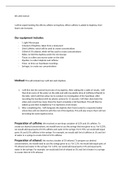6B caleb watson
I will be experimenting the effects caffeine on Daphnia. When caffeine is added to Daphnia, their
heart rate increases.
Our equipment includes:
- 1 Light Microscope
- A bucket of Daphnia, taken from a local pond
- 20ml Caffeine, which will be used to create concentrations
- 100ml of 5% ethanol, which will be used to create concentrations
- Slides, to hold the daphnia under the microscope
- Tissue, to collect any excess water on the slide
- Pipettes, to collect daphnia and caffeine
- Timer, to time our heartbeat recordings
- Syringes, to create our concentrations
Method: This will include how I will test each daphnia.
1. I will first test the control heart rate of my daphnia. After adding this a table of results, I will
then drain some of the water on the slide and add one pipette drop of [caffeine/ethanol] to
the slide, which will then allow me to conduct my investigation of the heartbeat. After
recording the heartbeat with my phone camera for 15 seconds, I will then slow down the
video and record how many times the heart completes a full heartbeat. This will then be
added up and then multiplied by 4 to represent a full minute.
2. After completing this, I will designate the daphnia that I have tested to a separate beaker
where they will not interfere with the rest of the daphnia. This will also ensure that I will not
be testing the same daphnia twice.
Preparation of caffeine: We received an eye-drop container of 0.5% and 1% caffeine. To
create our desired concentrations, we would have to use the syringe that was given to us. For 0.25%,
we would add equal parts of 0.5% caffeine and water in the syringe. For 0.75%, we would add equal
parts 1% and 0.5% caffeine in the syringe. For example, we would add 5ml of caffeine at 1% and 5ml
of water in a syringe to create 10ml of 0.5% caffeine.
Preparation of ethanol: We receive a beaker of 5% ethanol. To prepare our desired
concentrations, we would need to use the syringe given to us. For 2.5%, we would add equal parts of
5% ethanol and water in the syringe. For 1.25%, we would add equal parts 2.5% and equal parts
water in the syringe. For example, we would add 5ml of ethanol at 5% and 5ml of water in a syringe
to create 10ml of 2.5% ethanol.
, Timetable:
Day 1 – This is the day that me and my team of colleagues requested and collected our equipment
for our investigation. The technicians were aware the day before that we would be starting our
investigation, so all the necessary equipment was available at the time of request. We started to use
our equipment and understand what we can do to complete the investigation efficiently and how to
record our results. We received the caffeine, ethanol, syringes and beakers, and then created our
concentrations using mathematics. We used tables to execute our record-taking, which helped us
easily fill in boxes and move along with our strenuous investigation quicker.
Day 2 – We started by agreeing to doing our caffeine experiments first, and then our ethanol
experiments next. We first checked the resting heartbeat of the daphnia that had not received
caffeine. We then drained the water surrounding the daphnia, and then put one pipette drop of
0.5% caffeine onto the slide. We then examined this though the microscope, observed that the
heartbeat was visibly faster after 10 seconds post administration, and then recorded the heartbeat
for 15 seconds on our phone cameras. We then counted the heartbeat by slowing down our video
and slowly counting the heartbeat. After this, we multiplied the heartbeat that we counted by 4 to
represent an entire minute.
Day 3 – We conducted an experiment on our second daphnia, which involved testing it’s heartrate
under the administration of 0.25% caffeine. We used the same method as above (day 2) and
recorded our results in a table. We added equal parts of water and 0.5% of caffeine in a syringe,
producing a concentration of 0.25%.
Day 4 – We conducted an experiment on our third daphnia, which involved testing its heartrate
under the final administration of caffeine at a concentration of 0.75%. We added equal parts of 0.5%
of caffeine and 1% of caffeine in a syringe, making a concentration of 0.75%.
Day 5 – We conducted an experiment on our fourth daphnia, in which we investigated the effects of
5% ethanol on the daphnia.
Day 6 – We conducted an experiment on our fourth daphnia, in which we investigated the effects of
2.5% ethanol on the daphnia. We achieved this concentration by adding equal parts of 5% ethanol
and water to make a concentration of 2.5% ethanol.
Day 7 – We conducted an experiment on our fourth daphnia, in which we investigated the effects of
1.25% ethanol on the daphnia. We achieved this concentration by adding equal parts of 2.5%
ethanol and equal parts water to make a concentration of 1.25% ethanol.
Day 8 - This is when me and my lab partners went over our results and checked that they aligned
with our secondary research. Thankfully, they aligned with the secondary research, which was
enough for us to conclude our investigation.
Risk assessment:




